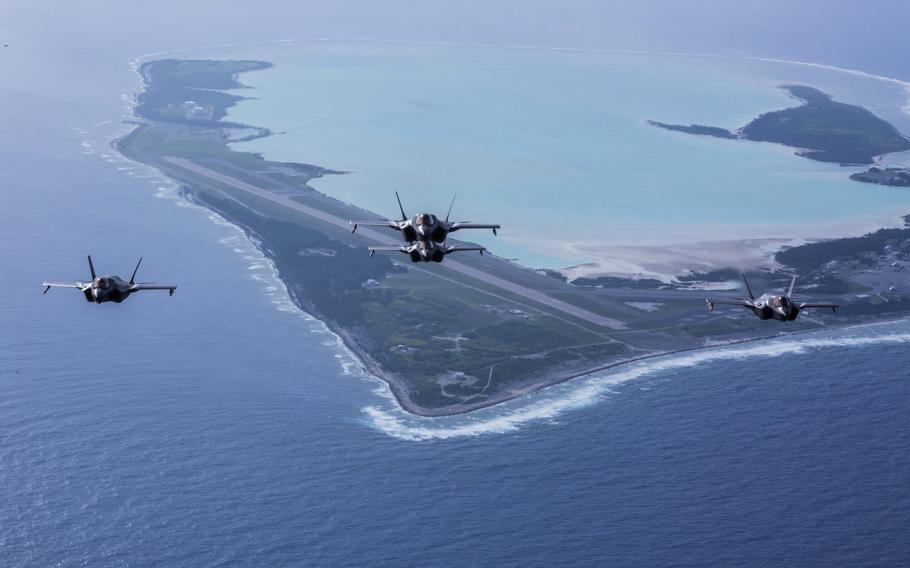
PF-35B Lightning IIs with Marine Fighter Attack Squadron 211, the Wake Island Avengers, 13th Marine Expeditionary Unit (MEU), fly over Wake Island in 2018. Wake Island, which is claimed by the Marshall Islands and remains under the control of the U.S. Air Force, is home to a massive 9, 800-foot runway at Wake Island Airfield — (Sgt. Francisco Diaz/U.S. Marine Corps)
(Tribune News Service) — The Navy announced it has awarded an $8 billion contract to 11 companies — including both local and mainland contractors — for a series of construction, maintenance and renovation projects to facilities, as well as the demolition of old facilities, in Hawaii and on Wake Island.
But how much of the pie each company will get, and what they’ll be working on specifically, isn’t clear.
In a news release, Naval Facilities Engineering Systems Command Hawaii, also known as NAVFAC, said the massive contract is expected to be completed by June 2033. NAVFAC said “the contractors were chosen using the best value source selection procurement method. Award for this procurement was based on technical factors and price, which together constitute a best value to the Government.”
The recipients listed were the Environmental Chemical Corp., Grunley Goodfellow JV, Hawaii-Wake MACC Construction, Hawaiian Dredging Construction Co., Hensel Phelps Construction Co., Kiewit Infrastructure West Co., The Korte Co., Nan Inc., Nordic PCL Construction, SLSCO Ltd. and The Whiting-Turner Contracting Co.
Navy officials did not respond to requests for information on how much of the $8 billion each company is receiving or what they are working on.
The Pentagon has in recent years been pouring money into Hawaii to bolster its Pacific forces amid tensions with China. But the military has also faced increasing scrutiny of its presence in the islands since jet fuel from the Navy’s underground Red Hill storage facility tainted the Navy’s Oahu water system, which serves 93, 000 people.
The Navy completed draining the World War II-era Red Hill facility in March of last year and is working to shut down the facility, which sits just 100 feet above a critical aquifer most of Oahu relies on for drinking water.
Many of the facilities the Navy has in Hawaii are outdated, and in some cases in desperate need of repairs, upgrades or outright replacement.
There have been ongoing problems with the Oahu water system, including main breaks and continued complaints of water contamination, as well as problems at Joint Base Pearl Harbor-Hickam’s aging waste water facility, which Navy officials have been seeking to ultimately replace if they can secure funding.
Last year, Congress appropriated more than $1.5 billion — roughly 8% of the worldwide military construction budget — for Hawaii alone. The biggest share of that appropriation — $1.2 billion — went to the Pearl Harbor Naval Shipyard for Dry Dock 5, which is the single most expensive construction project in the Navy’s history.
Dry Dock 5 is expected to cost at least $3.4 billion when it is completed in 2028, not including upkeep, maintenance and operations costs. It will replace the current Dry Dock 3, which will become functionally obsolete once the Navy retires the last of its Los Angeles-class submarines. Built in 1942, Dry Dock 3 is unable to service the Navy’s newer Virginia-class submarines or larger surface ships.
Wake Island, which is claimed by the Marshall Islands and remains under the control of the U.S. Air Force, is home to a massive 9, 800-foot runway at Wake Island Airfield — one of the longest military runways in the Pacific. In 2020, the Air Force announced an $87 million plan to renovate it.
The Pentagon has been reinvesting in facilities across the Pacific islands. Last year, the military released photos of troops from the Kaneohe-based 3rd Marine Littoral Regiment training on Wake Island. It is not clear what NAVFAC has planned for the small atoll.
© 2025 The Honolulu Star-Advertiser.
Visit www.staradvertiser.com.
Distributed by Tribune Content Agency, LLC.